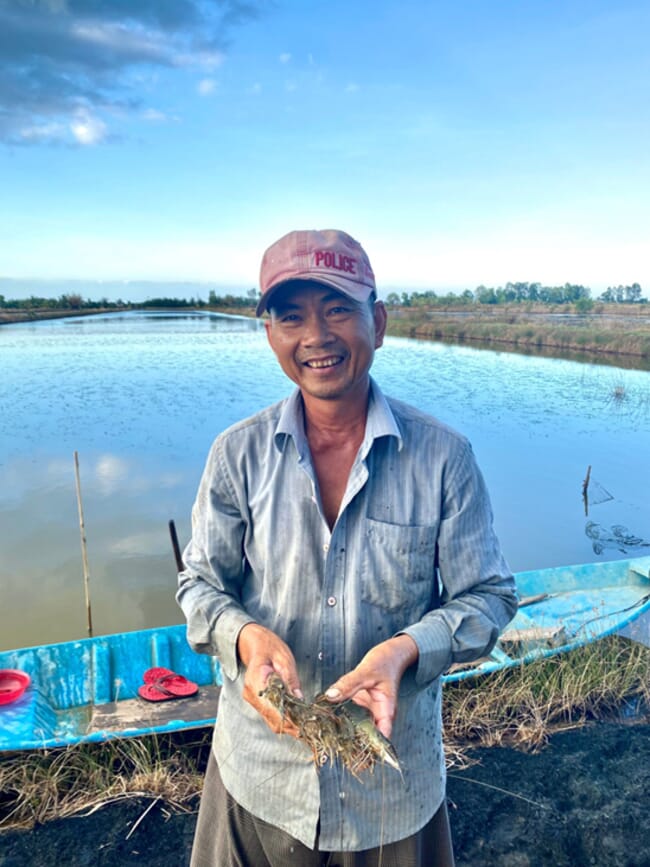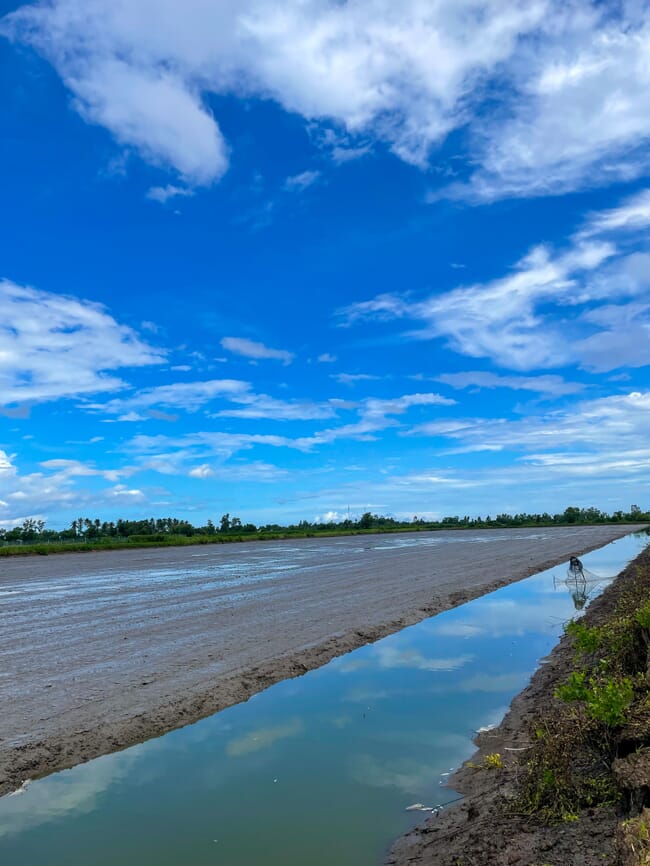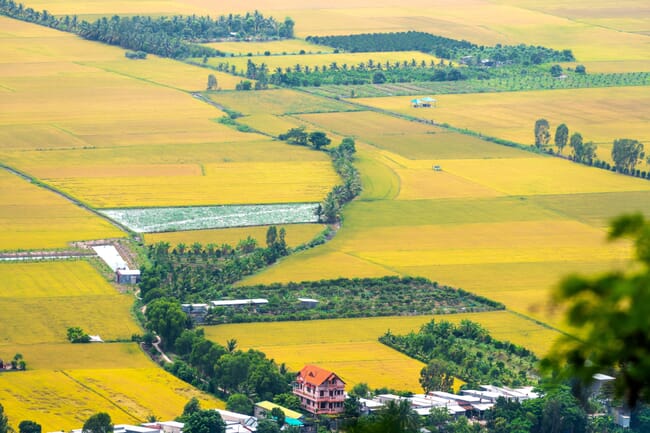
© Minh Phu
Rice and shrimp are an awesome mix, as lovers of paella and Chinese fried rice will swear. But can they be mixed in the same plot of land? In the face of climate change and other anthropogenic shifts in the environment, modern farmers must be nimble enough to adapt to a rapidly changing world.
Our previous story about Vietnam’s Mekong Delta examined the worsening case of subsidence in the region and the continued erosion of riverbanks due to excessive groundwater extraction and sand mining.
“The Mekong Delta is being hit from both sides. It is sinking, but it is also being inundated by rising sea levels, which is claiming an additional three millimeters of height yearly,” explained aquaculture consultant Steven Starmans from Kim Delta.
Because of this, the delta is sinking by around 4.3 centimetres yearly – not much at first glance, until you realise that most of it sits just a metre above sea level.
Consequently, seawater now penetrates over 70 kilometres inland, compared to just 20 kilometres a few years back. Obviously, salt and most crops don’t mix well and the livelihoods of many farmers are at risk. A recent study by Vietnam’s Water Resources Science Institute estimated that the Mekong Delta is losing USD 3 billion yearly in crops due to seawater intrusion. This spells not just hardship for farmers, but also possible hunger for millions, as Vietnam is the region’s biggest rice exporter.
The local shrimp farming sector isn’t doing too well either, as high stocking densities have led to decreased water quality and the proliferation of diseases.
Adapting to challenging conditions
Always on the lookout for innovative solutions, The Fish Site spoke with a leading Vietnamese shrimp processor which has found a way for both rice and shrimp farmers to adapt to saline conditions – potentially playing an important role in future-proofing the Mekong Delta’s hardworking farmers.
Minh Phu Seafood Corporation works closely with the government and local farmers to improve local practices and ensure long-term sustainability and food security. Besides super-intensive recirculating pond systems using biofloc, the company has also been increasingly engaged in exploring extensive shrimp farming systems, developing a working model for natural shrimp mangrove farming and currently reviving and modernising a traditional rice-shrimp farming model.
“Simply put, we can farm shrimp during the dry season when seawater intrusion is strongest. Once the monsoon season sets in to inundate the floodplain with freshwater, we can switch back to farming rice. We call this the rice-shrimp farming model,” explains Minh Phu’s CEO, Le Van Quang.
The system’s hallmark is to understand the natural movement of water each season to restore productivity in the areas most affected by salt intrusion. Instead of endlessly fighting to keep saltwater away from rice fields, the system just goes with the flow and makes the best of the available saltwater.
A dual farming system
Each summer, during the dry season, seawater flows inland, making the delta’s coastal plains less conducive to rice farming – but ideal environments for shrimp culture.
Shrimp, particularly native black tiger prawns (Penaeus monodon), can be raised utilising the natural food supply from the decomposing rice plant roots, which serve as temporary homes for a host of aquatic organisms.
“The rice plant residues, straw and husks create a rich food source for aquatic organisms, providing a nutritious diet while enhancing the farmed shrimp's resilience. The circulation and development of nutrients, microorganisms and aquatic animals between saline and freshwater ecosystems create ideal conditions for both shrimp and rice to flourish,” says Quang.
The high-salt ecosystem kills most rice plant diseases, making it possible to grow rice without pesticides and fertilisers. Two rice varieties are used for this: ST24 and ST25, which are known to be extra-fragrant and salt-tolerant. The farmers have so far found that rice grown in slightly salty water is actually tastier and more fragrant.
When the rainy season finally brings in freshwater, the shrimp ponds revert to lush rice fields. Nutrients, shrimp waste and flocs enrich the fields, forming natural organic fertiliser to supercharge rice growth. The inbound freshwater, in turn, kills pathogens from the saline ecosystem, allowing shrimp farming without the need for medication or artificial feed, relying entirely on natural conditions.
“The cycle of alternating between two water seasons and two contrasting living environments has many advantages, promoting balance and sustainability in farming. Each component serves as both the output and the input for each other within a closed-loop system, optimising resources and material flows,” Quang notes.
Salinisation concerns?
One ecological concern is that the brackish water used for shrimp farming will increase the salinity of the soil further. However, Quang explains that during the rainy season in the rice-shrimp farming areas, people use a special salt-washing technique that reduces the salinity in the shrimp ponds to zero without the need to pump in freshwater.
Locals use rainwater to wash the salt away and the system is currently working well. Results from water measurements in drilled wells show no saltwater intrusion into groundwater reservoirs. In addition, Minh Phu only promotes this farming model in areas that are worst affected by salt intrusion and which would likely be forced into shrimp farming monoculture if the situation gets worse.

Scaling up
The model is now gaining in popularity and the company is collaborating with farmers covering over 4,000 hectares – the average farmer cultivates 2-hectares – and Minh Phu aims to expand this to 20,000 hectares by 2030.
In areas where the salinity is high year-round, the company promotes intensive monoculture of monodon using HDPE liners and filtration systems to reuse the water. In addition, the company is also expanding its extensive mangrove rice farming model, with over 10,000 hectares of shrimp-mangrove plots currently in operation – a figure that’s expected to double in the next two years.
The unique, highly adaptive characteristic of the rice-shrimp farming model has made it an environmentally friendly system that can be field-tested outside the Mekong Delta, particularly in tropical or subtropical areas where seawater intrusion is becoming a problem for rice farmers.
Economic gains
The payoff is around five to eight tonnes of rice and 300 to 1,000 kilogrammes of shrimp perhectare, per harvest cycle. Annual income from this model ranges from a minimum of USD 9,800 to an average of $20,000 and can reach nearly $40,000 per hectare with successful cultivation.
The rice is primarily sold locally, with the price of the fragrant rice strains around 80 percent higher than regular varieties. The farmed shrimp also fetches a much higher price, with most being exported to sustainably conscious consumers in Europe and the United States.
In the short term, the total income per hectare might be slightly less than from intensive monoculture , as farmers need to learn new skills. However, just last year, WWF conducted an independent study on the investment model for rice-shrimp in the Mekong Delta (unpublished) and their research showed some interesting results when comparing a monoculture approach with an integrated approach to farming:
- Model 1: Only rice (ST24, ST25 varieties). Average profit $656/ha/year
- Model 2: Only black tiger shrimp. Average profit: $1,353/ha/year
- Model 3*: Integrated rotational farming of black tiger shrimp and rice. Average profit: $2,650/ha/year
*While also harvesting some sea crabs during the saline season and giant freshwater prawns during the freshwater season.
Besides the financial gains it is of equal importance to note that farmers opting for rice-shrimp farming face fewer production risks, as there are fewer diseases in comparison to an intensive monoculture approach. The risk is also spread by producing more than one type of crop.

© CIRAD
The way forward
“Minh Phu has been collaborating with the national government and local farmers to implement and develop the shrimp-rice model to achieve ASC / BAP / organic and ecological certifications, with the goal of expanding operations throughout the Mekong Delta. This helps our farmers secure higher market prices and better lives for themselves and their families,” notes Quang.
“All we need are more investments to scale up and enhance the productivity of the Mekong Delta, even in the face of climate change and the human-induced challenges the world is facing,” he adds.
With its great potential, all-round sustainability and commitment to the efficient use of resources, we believe that the rice-shrimp farming model can create more integrated and resilient farming systems for the Mekong Delta, as well as other places where seawater is intruding deeper and deeper inland.




